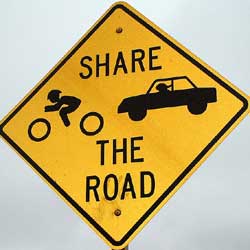 It’s hard to find an online forum discussing bike lanes—or even cyclists in general—without inadvertently stumbling across another “us versus them” debate about motorists being irritated with bikers who ignore traffic laws, and cyclists decrying drivers who don’t understand how hard it is to come to a complete stop and regain momentum at every controlled intersection. Now the debate is raging on, with law enforcement trying to figure out where to draw the line between policing offenders and educating cyclists about acceptable riding behavior.
It’s hard to find an online forum discussing bike lanes—or even cyclists in general—without inadvertently stumbling across another “us versus them” debate about motorists being irritated with bikers who ignore traffic laws, and cyclists decrying drivers who don’t understand how hard it is to come to a complete stop and regain momentum at every controlled intersection. Now the debate is raging on, with law enforcement trying to figure out where to draw the line between policing offenders and educating cyclists about acceptable riding behavior.
Under California law, cyclists have the same responsibilities to obey traffic laws as any other vehicle. As a result, rolling through a stop sign without first coming to a total halt is not only a ticketable offense, but can also earn the offender a point on their license. Regardless of whether cyclists agree with the law—and despite the obvious differences between a self-propelled bike and a motorized vehicle—the law still requires riders to bring their bike to a complete stop, a fact that goes ignored all too frequently.
A recent accident in which an exceptionally careless cyclist ended up killing a 71-year-old who was using a crosswalk only emphasizes the fact that bikes still have the potential to do serious harm in the event of a collision. And, there may be no single greater contributing factor to the common disdain many motorists feel toward cyclists than the perception that they’re a bunch of “arrogant scofflaws,” acting as if the law doesn’t apply to them whenever basic rules of the road prove inconvenient.
But how are police officers supposed to enforce violations? Should they hold cyclists to the same standard as motorists, or should they attack the problem on a case by case basis?
For example, take last week’s article in the Santa Monica Daily Press that highlighted a woman who received a $250 ticket for running a stop sign at a speed of 5 miles per hour. Surely something like this is a far cry from the man who recklessly failed to yield to pedestrians at a crosswalk. Isn’t a cyclist making a “California Stop” at a stop sign when there’s no other vehicles present the biking equivalent of a car doing a couple miles per hour over the speed limit? It’s technically illegal, but is it always worth enforcing?
The state of Idaho actually has a law on the books that allows cyclists to roll through stop signs under certain circumstances. It’s the only state in the country with a law of this kind. However, with California law as it stands, SFPD is trying to walk the line between punishing repeat offenders while also offering warnings to riders who may be genuinely unaware of how to navigate the streets legally on a bicycle. The SFMTA is also trying to emphasize rider education by hopefully implementing a program that would allow ticketed cyclists to waive the cost of their offense if they attended a rider education program.
It’s easy to become jaded whenever a cyclist tears through a red light or fails to wait their turn at a stop sign, but there are a massive amount of riders who honestly have no clue about following the rules of the road. Hopefully this “admonishment” approach coupled with increased education for naïve (or outright defiant) cyclists will begin to have a positive impact.
Neither drivers nor cyclists are going away anytime soon, so anything the two groups can do to coexist peacefully is a step in the right direction. And, as usual, obeying the law would be a great place to start.
Photo credit: https://www.flickr.com/photos/heypaul/2027460/

